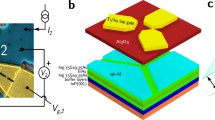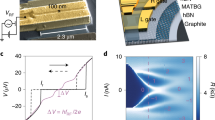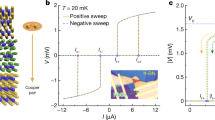Abstract
Coulomb drag refers to the phenomenon in which a charge current in one electronic circuit induces a responsive current in a neighbouring circuit solely through Coulomb interactions. For conventional interactions between electrons, the induced drag current in the passive layer is orders of magnitude weaker than the active current due to the strong dielectric screening effect between them. Here we show a Coulomb drag effect between an active normal conductor and a passive superconductor of Josephson junction arrays, where the passive current is of the same order as the active one. The drag force originates from the interactions between the substantially enhanced dynamical quantum fluctuations of the superconducting phases in the passive layer and normal electrons in the active layer. We demonstrate this effect in devices composed of monolayer graphene and LaAlO3/SrTiO3 heterointerface. The estimated passive-to-active ratio can reach about 0.3 at the optimal gate voltage and the temperature dependence follows that of the typical Josephson energy between superconducting puddles. From an engineering perspective, our device may work as a current or voltage transformer, and the drag mechanism lays the foundation for synchronizing Josephson-junction-array-based terahertz radiators.
This is a preview of subscription content, access via your institution
Access options
Access Nature and 54 other Nature Portfolio journals
Get Nature+, our best-value online-access subscription
$29.99 / 30 days
cancel any time
Subscribe to this journal
Receive 12 print issues and online access
$209.00 per year
only $17.42 per issue
Buy this article
- Purchase on Springer Link
- Instant access to full article PDF
Prices may be subject to local taxes which are calculated during checkout




Similar content being viewed by others
Data availability
Source data are provided with this paper. All other data that support the plots within this paper and other findings of this study are available from the corresponding authors on reasonable request.
References
Gramila, T. J., Eisenstein, J. P., MacDonald, A. H., Pfeiffer, L. N. & West, K. W. Mutual friction between parallel two-dimensional electron systems. Phys. Rev. Lett. 66, 1216–1219 (1991).
Eisenstein, J. P. New transport phenomena in coupled quantum wells. Superlattices Microstruct. 12, 107–114 (1992).
Price, A., Savchenko, A., Narozhny, B., Allison, G. & Ritchie, D. Giant fluctuations of Coulomb drag in a bilayer system. Science 316, 99–102 (2007).
Yamamoto, M., Stopa, M., Tokura, Y., Hirayama, Y. & Tarucha, S. Negative Coulomb drag in a one-dimensional wire. Science 313, 204–207 (2006).
Laroche, D., Gervais, G., Lilly, M. & Reno, J. 1D-1D Coulomb drag signature of a Luttinger liquid. Science 343, 631–634 (2014).
Eisenstein, J. P. & MacDonald, A. H. Bose–Einstein condensation of excitons in bilayer electron systems. Nature 432, 691–694 (2004).
Su, J.-J. & MacDonald, A. H. How to make a bilayer exciton condensate flow. Nat. Phys. 4, 799–802 (2008).
Nandi, D., Finck, A. D. K., Eisenstein, J. P., Pfeiffer, L. N. & West, K. W. Exciton condensation and perfect Coulomb drag. Nature 488, 481–484 (2012).
Liu, X., Watanabe, K., Taniguchi, T., Halperin, B. I. & Kim, P. Quantum Hall drag of exciton condensate in graphene. Nat. Phys. 13, 746–750 (2017).
Li, J., Taniguchi, T., Watanabe, K., Hone, J. & Dean, C. Excitonic superfluid phase in double bilayer graphene. Nat. Phys. 13, 751–755 (2017).
Narozhny, B. & Levchenko, A. Coulomb drag. Rev. Mod. Phys. 88, 025003 (2016).
Du, L. et al. Coulomb drag in topological wires separated by an air gap. Nat. Electron. 4, 573–578 (2021).
Giaever, I. Magnetic coupling between two adjacent type-II superconductors. Phys. Rev. Lett. 15, 825–827 (1965).
Giaever, I. Flux pinning and flux-flow resistivity in magnetically coupled superconducting films. Phys. Rev. Lett. 16, 460–462 (1966).
Averin, D. V., Korotkov, A. N. & Nazarov, Y. V. Transport of electron-hole pairs in arrays of small tunnel junctions. Phys. Rev. Lett. 66, 2818–2821 (1991).
Duan, J.-M. & Yip, S. Supercurrent drag via the Coulomb interaction. Phys. Rev. Lett. 70, 3647–3650 (1993).
Giordano, N. & Monnier, J. D. Cross-talk effects in superconductor-insulator-normal-metal trilayers. Phys. Rev. B 50, 9363–9368 (1994).
Huang, X., Bazàn, G. & Bernstein, G. H. Observation of supercurrent drag between normal metal and superconducting films. Phys. Rev. Lett. 74, 4051–4054 (1995).
Shimshoni, E. Role of vortices in the mutual coupling of superconducting and normal-metal films. Phys. Rev. B 51, 9415–9418 (1995).
Shimada, H. & Delsing, P. Current mirror effect and correlated Cooper-pair transport in coupled arrays of small Josephson junctions. Phys. Rev. Lett. 85, 3253–3256 (2000).
Zou, Y., Refael, G. & Yoon, J. Investigating the superconductor-insulator transition in thin films using drag resistance: theoretical analysis of a proposed experiment. Phys. Rev. B 80, 180503 (2009).
Levchenko, A. & Norman, M. R. Proposed Giaever transformer to probe the pseudogap phase of cuprates. Phys. Rev. B 83, 100506 (2011).
Andreev, A. & Bashkin, E. Three-velocity hydrodynamics of superfluid solutions. Sov. Phys. JETP 42, 164–167 (1976).
Alpar, M., Langer, S. A. & Sauls, J. Rapid postglitch spin-up of the superfluid core in pulsars. Astrophys. J. 282, 533–541 (1984).
Kim, S. et al. Coulomb drag of massless fermions in graphene. Phys. Rev. B 83, 161401 (2011).
Gorbachev, R. V. et al. Strong Coulomb drag and broken symmetry in double-layer graphene. Nat. Phys. 8, 896–901 (2012).
Gamucci, A. et al. Anomalous low-temperature Coulomb drag in graphene-GaAs heterostructures. Nat. Commun. 5, 5824 (2014).
Reyren, N. et al. Superconducting interfaces between insulating oxides. Science 317, 1196–1199 (2007).
Chen, Z. et al. Carrier density and disorder tuned superconductor-metal transition in a two-dimensional electron system. Nat. Commun. 9, 4008 (2018).
Caviglia, A. et al. Electric field control of the LaAlO3/SrTiO3 interface ground state. Nature 456, 624–627 (2008).
Bert, J. A. et al. Direct imaging of the coexistence of ferromagnetism and superconductivity at the LaAlO3/SrTiO3 interface. Nat. Phys. 7, 767–771 (2011).
Manca, N. et al. Bimodal phase diagram of the superfluid density in LaAlO3/SrTiO3 revealed by an interfacial waveguide resonator. Phys. Rev. Lett. 122, 036801 (2019).
Hurand, S. et al. Josephson-like dynamics of the superconducting LaAlO3/SrTiO3 interface. Phys. Rev. B 99, 104515 (2019).
Prozorov, R. & Giannetta, R. W. Magnetic penetration depth in unconventional superconductors. Supercond. Sci. Technol. 19, R41 (2006).
Kapitulnik, A., Kivelson, S. A. & Spivak, B. Colloquium: anomalous metals: failed superconductors. Rev. Mod. Phys. 91, 011002 (2019).
Alexandrov, A. S. & Kornilovitch, P. E. Mobile small polaron. Phys. Rev. Lett. 82, 807–810 (1999).
Bogoljubov, N. N., Tolmachov, V. V. & Širkov, D. V. A new method in the theory of superconductivity. Fortschr. Phys. 6, 605–682 (1958).
Anderson, P. W. Coherent excited states in the theory of superconductivity: gauge invariance and the Meissner effect. Phys. Rev. 110, 827–835 (1958).
Goldstone, J. Field theories with superconductor solutions. Nuovo Cim. 19, 154–164 (1961).
Ramezanali, M. R., Vazifeh, M. M., Asgari, R., Polini, M. & MacDonald, A. H. Finite-temperature screening and the specific heat of doped graphene sheets. J. Phys. 42, 214015 (2009).
Berdanier, W., Scaffidi, T. & Moore, J. E. Energy drag in particle-hole symmetric systems as quantum quench. Phys. Rev. Lett. 123, 246603 (2019).
Casimir, H. B. G. On the attraction between two perfectly conducting plates. Proc. Kon. Ned. Akad. Wet. 51, 793–795 (1948).
Han, S., Bi, B., Zhang, W. & Lukens, J. E. Demonstration of Josephson effect submillimeter wave sources with increased power. Appl. Phys. Lett. 64, 1424–1426 (1994).
Barbara, P., Cawthorne, A. B., Shitov, S. V. & Lobb, C. J. Stimulated emission and amplification in Josephson junction arrays. Phys. Rev. Lett. 82, 1963–1966 (1999).
Galin, M. A. et al. Direct visualization of phase-locking of large Josephson junction arrays by surface electromagnetic waves. Phys. Rev. Appl. 14, 024051 (2020).
Saito, Y., Nojima, T. & Iwasa, Y. Highly crystalline 2D superconductors. Nat. Rev. Mater. 2, 16094 (2017).
Gong, C. & Zhang, X. Two-dimensional magnetic crystals and emergent heterostructure devices. Science 363, eaav4450 (2019).
Liang, H. et al. Nonmonotonically tunable Rashba spin-orbit coupling by multiple-band filling control in SrTiO3-based interfacial d-electron gases. Phys. Rev. B 92, 075309 (2015).
Li, X. et al. Large-area synthesis of high-quality and uniform graphene films on copper foils. Science 324, 1312–1314 (2009).
Cheng, L. et al. Photoconductivity of graphene in proximity to LaAlO3/SrTiO3 heterostructures: phenomenon and photosensor applications. Phys. Rev. Appl. 6, 014005 (2016).
Acknowledgements
We thank F. Wu for helpful discussions. R.T., L.L., X.F., L.G., L.Z., Y.Y., Z.Z. and C.Z. were supported by the National Natural Science Foundation of China (grant nos. 92165201, 11804326, 11974324), the Innovation Program for Quantum Science and Technology (grant no. 2021ZD0302800), the CAS Project for Young Scientists in Basic Research (grant no. YSBR-046), the Strategic Priority Research Program of Chinese Academy of Sciences (grant no. XDC07010000), the Anhui Initiative in Quantum Information Technologies (grant no. AHY170000), Hefei Science Center CAS (grant no. 2020HSC-UE014) and the Fundamental Research Funds for the Central Universities (grant no. WK3510000013). L.L. was also supported by USTC Tang Scholar. H.-Y.X. was supported by the National Natural Science Foundation of China (grant no. 12074039). Part of this work was carried out at the Center for Micro- and Nanoscale Research and Fabrication, University of Science and Technology of China.
Author information
Authors and Affiliations
Contributions
C.Z. and L.L. designed and supervised the work. R.T. and L.L. performed the experiments with assistance from X.F., L.G., L.Z. and Y.Y. H.-Y.X. conceived the theoretical model. L.L., R.T., H.-Y.X. and C.Z. analysed the data and wrote the manuscript. Z.Z. contributed to data interpretation and presentation. All authors contributed to the scientific discussion and manuscript revisions.
Corresponding authors
Ethics declarations
Competing interests
The authors declare no competing interests.
Peer review
Peer review information
Nature Physics thanks Dimitrie Culcer, James Williams and the other, anonymous, reviewer(s) for their contribution to the peer review of this work.
Additional information
Publisher’s note Springer Nature remains neutral with regard to jurisdictional claims in published maps and institutional affiliations.
Extended data
Extended Data Fig. 1 Berezinskii-Kosterlitz-Thouless transition of LAO/STO interface in the final G-LAO/STO Devices.
a,d, The V-I curves of the LAO/STO interface plotted on a semi-log scale for Devices #1 and #3, respectively. In a, the black lines are V ∝ Iα fits of the data in the transition region, and the gray line corresponds to the V ∝ I3 dependence. In d, the black and gray lines correspond respectively to V ∝ I and V ∝ I3 dependencies. b,e, T-dependence of the exponent α, as deduced from the fits shown in a and d, respectively. c,f, R-T curves of the LAO/STO interface plotted on a [dln(R)/dT]-2/3 scale for Devices #1 and #3, respectively.
Extended Data Fig. 2 Negligible impact of the back-gate voltage on the doping level of graphene.
a, Schematic illustration of the back-gate voltage (VBG) tuning. b,c, RLAO/STO and Rgraphene as functions of VBG measured at 400 mK and 100 mK, respectively.
Extended Data Fig. 3 Negligible impact of the interlayer-gate voltage on the electronic performance of LAO/STO interface.
a, Schematic illustration of the interlayer-gate voltage (Vint) tuning. b, RLAO/STO as a function of Vint measured at 100 mK and 400 mK. In contrast to graphene (Fig. 1c in the main text), the impact of Vint on the electronic performance of LAO/STO interface is negligible. This is due to the fact that the typical carrier density of the LAO/STO interface is orders of magnitude higher than that of the graphene layer near the Dirac point.
Extended Data Fig. 4 Exclusion of the impact of interlayer leakage/tunneling on the observed drag signal.
a,b, Schematic diagrams of the drag set-ups where the grounded point at the LAO/STO interface is switched. c, Comparison of Vdrag-Idrive curves for two different set-ups measured at T = 200 mK and VBG = 0 V.
Extended Data Fig. 5 Negligible interlayer leakage.
Interlayer leakage current as a function of Vint for different VBG.
Extended Data Fig. 6 Drag resistances in different G-LAO-STO devices.
a,b, Rdrag and RLAO/STO as functions of T for Devices #2 and #3, respectively. Insets: enlarged-views of the RLAO/STO vs T curves. For Device #3, non-zero Rdrag is obtained even at the lowest measuring temperature, which is consistent with the fact that the LAO/STO interface acting as the drag layer does not enter into the fully SC state.
Extended Data Fig. 7 Evolution of drag effect under magnetic field applied perpendicular to the interfacial plane of LAO/STO.
From top to bottom: Rdrag and RLAO/STO as functions of T measured under 0 T, 0.05 T and 0.5 T magnetic field, respectively.
Extended Data Fig. 8 Counter-current measurements.
a, Schematic illustration of the set-up for the counter-current measurement. b, VLAO/STO as a function of ILAO/STO measured with varying Igraphene (Idrive). The measurements were conducted at T = 200 mK and VBG = 0 V in Device #1. c, VLAO/STO as a function of ILAO/STO and Igraphene (Idrive).
Extended Data Fig. 9 Evolution of drag resistance with the doping level of graphene.
a, Schematic illustration for the drag set-up, where the carrier density/polarity of graphene can be readily tuned using the interlayer-gate voltage (Vint). b, Rdrag and Rgraphene as functions of Vint. The measurements were conducted at T = 40 mK and VBG = 0 V in a G-LAO/STO device with 14-unit-cell LAO (Device #4).
Extended Data Fig. 10 Fits of the drag coefficient of PAR (r = -Rdrag/RLAO/STO) for Device #3.
r as a function of T and the corresponding fitting curves obtained using equations r(T) = r0[1-(T/T*)2] (orange dashed line) and r(T) = r0[1-(T/TP)2]exp(-T/T0) (black dashed line). Inset: The corresponding semi-log plots. The experiments were conducted at VBG = 0 V. Via the fitting, the ratio r at the zero-temperature limit is estimated to be around 0.8×104.
Supplementary information
Supplementary Information
Supplementary Sections 1–6, Figs. 1–4 and Table 1.
Source data
Source Data Fig. 1
Statistical source data.
Source Data Fig. 2
Statistical source data.
Source Data Fig. 3
Statistical source data.
Source Data Fig. 4
Statistical source data.
Rights and permissions
Springer Nature or its licensor (e.g. a society or other partner) holds exclusive rights to this article under a publishing agreement with the author(s) or other rightsholder(s); author self-archiving of the accepted manuscript version of this article is solely governed by the terms of such publishing agreement and applicable law.
About this article
Cite this article
Tao, R., Li, L., Xie, HY. et al. Josephson–Coulomb drag effect between graphene and a LaAlO3/SrTiO3 superconductor. Nat. Phys. 19, 372–378 (2023). https://doi.org/10.1038/s41567-022-01902-7
Received:
Accepted:
Published:
Issue Date:
DOI: https://doi.org/10.1038/s41567-022-01902-7



